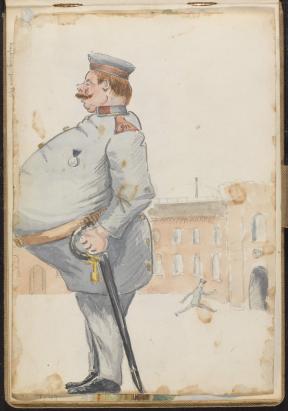A World War One British Army Lieutenant Colonel learned how to while away the hours as a prisoner-of-war in Germany, by taking up drawing and painting.
Lieutenant Colonel Reginald Bond, from Wiltshire in South West England, was captured in the first few months of World War One and was interned at a prisoner-of-war camp in Germany. As a senior officer, Reginald and his senior colleagues were not expected to do manual labour like the more junior prisoners.
They found that they had hours and hours every day to do nothing. So Reginald took up an easel, paints and pencils and began to draw and paint the scenes and landscapes he could see from the prison camp.
The collection of drawings and paintings survived and now, one hundred years later, they give a realistic insight into what it was like in a German prisoner-of-war camp during World War One.
The collection is housed at the National Army Museum in London and this year, to mark the 100th anniversary of World War One, the museum is making the entire collection available online for the public to view.
Lieutenant Colonel Bond had been in the Army his whole life and was 48 when World War One began in 1914.
Whilst at the prison camp, he watched his colleagues and other prisoners, as well as the German guards and workmen. He recorded their day-to-day activity and captured the life of the prison camp in watercolours and pencil sketches.
The camp was at Magdeburg, in North East Germany.
As the war began, Lieutenant Colonel Bond was sent to the front lines and was in charge of a battalion at the Battle of Mons. Hundreds died in the trenches and Reginald’s battalion got cut off by the advancing German troops and they were all taken prisoner. They were initially taken to Le Cateau and then transferred to Magdeburg a few months later, along with prisoners from all the Allied countries.
Lieutenant Colonel Bond ended up spending the entire war as a prisoner at Magdeburg, the Western Daily Press reports.
Many of the Lieutenant Colonel’s drawings show the lifeless days the prisoners had, whiling away the hours eating and reading. Prisoners depicted are from all around Europe, including France and Belgium, as well as Russia. The officer also captured the German guards as overweight and the medieval Magdeburg skyline from above the prison’s walls.
While imprisoned at the camp, Lieutenant Colonel Bond’s family was told that he had been killed in action and they held a memorial service in his honour. They were eventually told the truth that he had been taken prisoner and he returned home after the war ended.
Lieutenant Colonel Bond was born in Wiltshire in 1866 and attended Bath College and Trinity College at Oxford. He then joined the British Army when he was 22. By the time World War One came along, he had been hoping to retire but instead had to spend the next four years in captivity.
